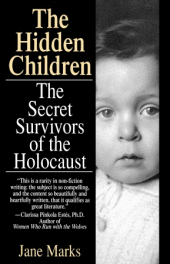The Hidden Children: the secret survivors of the Holocaust
(by guest contributor Tracy S. Doyle)
I recently spent several days reading an incredible book entitled The Hidden Children: The Secret Survivors of the Holocaust by Jane Marks. This powerful book included the wartime stories of twenty-three survivors and how their childhoods were sacrificed to save their lives. Their bravery, strength, and determination to survive are evident in each story. Often separated from their families for weeks or even years at a time, most of these children led secret lives…secret lives that saved their lives.
One of the burning questions I have had about the Holocaust is why more people didn’t step up and help? Surely they saw the Jews being publicly humiliated, forced into disease-ridden, overcrowded ghettos, and shipped off to their imminent death, so why didn’t people do anything? The answer is people did. Hundreds, possibly even thousands, of “righteous Gentiles” saved Jewish children by hiding them. Through an elaborate underground network, against horrendous odds, children were saved. They were hidden in convents, attics, cellars, cupboards, forests, and barns; some were even secreted away in sewers. These were far from ideal living quarters, but the hidden children were living when most other Jewish children were being gassed by the Nazis.
The book tells of Jewish children rescued by courageous Christian families who adopted and treated them as their own until after the war when their real parents, sometimes complete strangers, returned to claim them. Several of the survivors recall being “ripped” from the arms of the only parents they had ever known and given to strangers. Many of the youngest children were never told they were Jewish for fear that they would “slip” and identify themselves to the wrong person, which would result in certain death for the outed child and her Gentile protectors. These stories were particularly heart-wrenching when, even as adults, tears streamed down their faces as they recalled leaving their “hidden parents” whom they loved and had saved them.
| Marks groups the survivor stories into four sections–the Ordeal, the Aftermath, the Legacy and the Healing. Section one, the Ordeal, tells the horrors of going into hiding and the excrutiating decisions Jewish families made to ensure their children’s survival. As a mother of two young girls I can only begin to imagine what these parents must have gone through and the difficult choices they had to make to save their children. It made me question what I would have done. Could I have given my child to a stranger, knowing their chance of surviving the war was better apart from me? Could I walk away listening to them scream for me? Could I live knowing that, chances are, I may never see them again? What a horrifying dilemna for any mother to face.In section two, the Aftermath, Marks tells how each survivor’s life was affected by their time in hiding. Their entire lives have been marked by fear and hurt, many of them still frightened little children, emotionally frozen in time at the age of four, seven or twelve. Even as adults, they’ve remained hidden emotionally. Learning at an early age to turn off anger, fear, confusion, and grief, in effect, they stopped feeling anything. This emotional disconnect resulted in insecurities, marriages failing and relationships lacking intimacy. By telling their story, many say they have finally begun the process of emotional healing.Section three, the Legacy, deals with how these children describe their lives as a puzzle with too many pieces missing. They have many questions without answers. Their ability to forget was a way to survive emotionally but it had a downside; it left them with unknowns about what they experienced as a child. One survivor put a positive spin on this by saying “I have an almost instinctive appreciation of the concept of fate and destiny, that certain things happen in life that are beyond our control. Instead of making me scared, that’s given me a clearer understanding of what I can do something about — and what I can’t” (p. 182). |
|
And finally, the Healing, relates how, amazingly, the hidden children have grown-up to be very successful and contributing members of societies all around the world. They all strive to denounce anti-Semitism and other forms of racism and to promote education so that, God forbid, if ever confronted with the concept of such a horrifying proposal the next generation will stand and say “Never Again!”
(The Hidden Children: the secret survivors of the Holocaust by Jane Marks, Fawcett Columbine, New York, 1993, ISBN 044990685X)

October 8, 2009 at 10:49 AM
“Aftermath, Marks tells how each survivor’s life was affected by their time in hiding. Their entire lives have been marked by fear and hurt, many of them still frightened little children, emotionally frozen in time at the age of four, seven or twelve. Even as adults, they’ve remained hidden emotionally. Learning at an early age to turn off anger, fear, confusion, and grief, in effect, they stopped feeling anything. This emotional disconnect resulted in insecurities, marriages failing and relationships lacking intimacy. By telling their story, many say they have finally begun the process of emotional healing.”
I was not hidden, my family and I hid many people during WW2. I was a child in the Dutch Underground Resistance and my ‘Aftermath’ was/is very much the same as theirs. Happy to see you posted this book. It will help people to understand … I hope.
I was well in my sixties when I told my story in ‘Rachel Sarai’s Vineyard’, and am still hoping to emotionally heal. It was launched on September 19th in London.
http://www.immasgirl.blogspot.com
December 3, 2011 at 11:07 PM
The Secret…
[…]The Hidden Children: the secret survivors of the Holocaust « Never Again![…]…